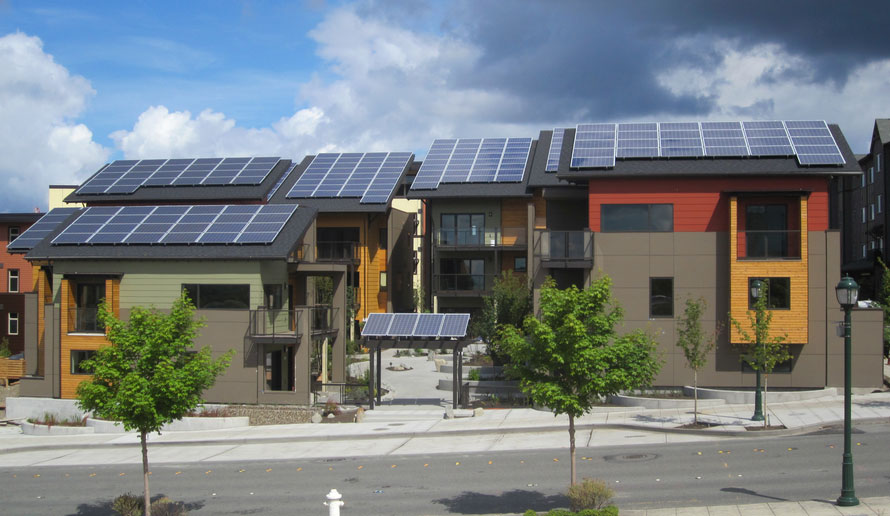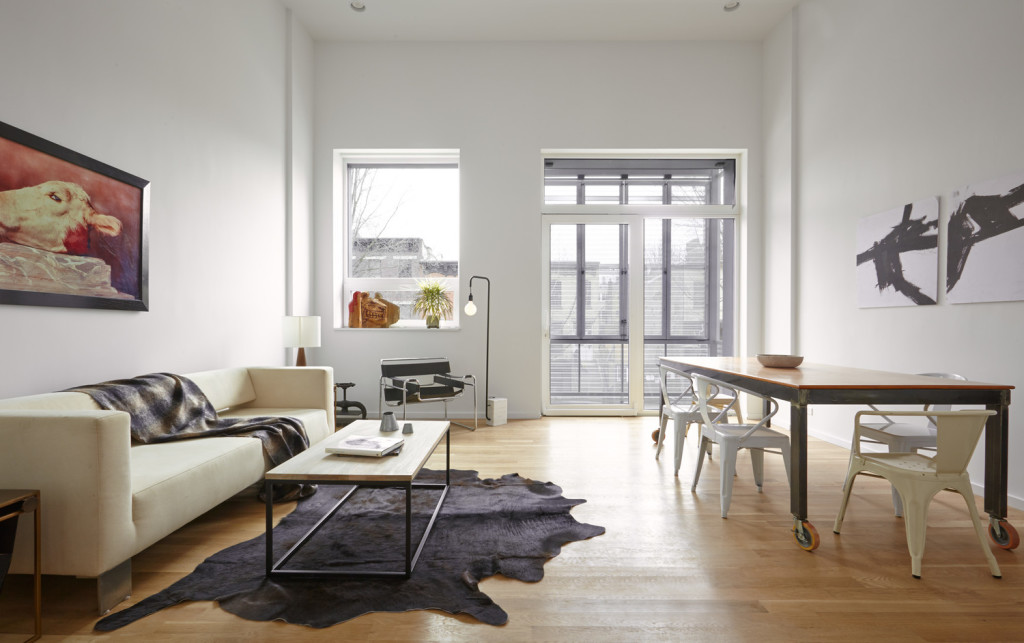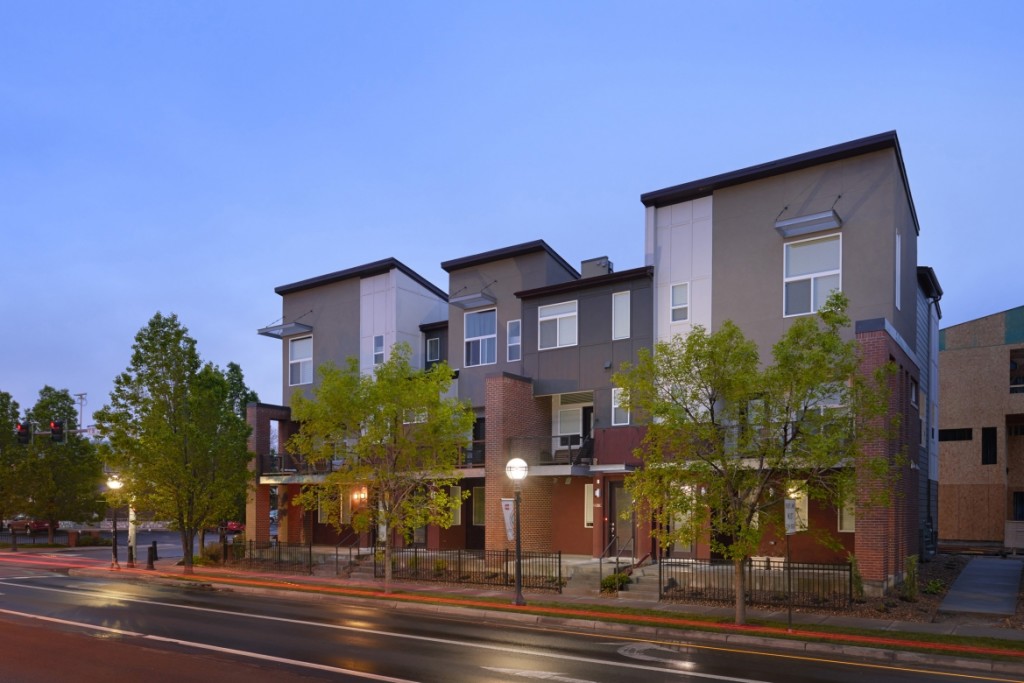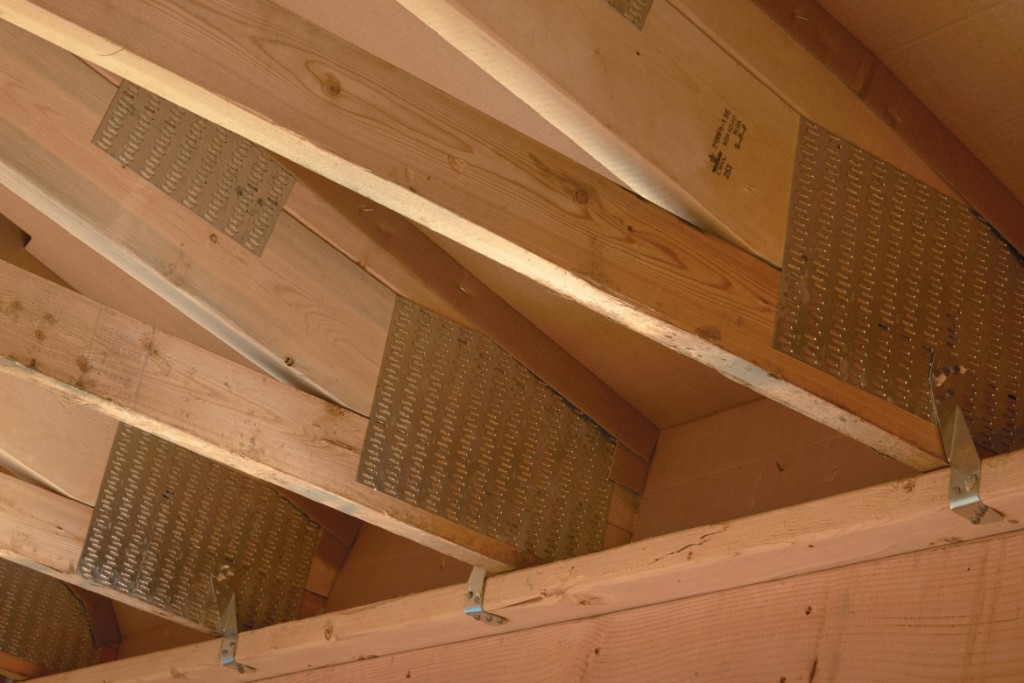In 2014, 35 percent of all housing units constructed in the United States were multifamily units—housing units in buildings with five or more units. Demand for multifamily options for housing is stronger than ever and reports indicate that this trend will continue for a while.
Multifamily buildings, both existing and new, present a tremendous opportunity for very significant energy savings and some are going for Zero Energy status through innovative building techniques and highly efficient systems, lighting and appliances. Here we explore three examples of multifamily buildings that are Zero Energy or Zero Energy Ready.
zHome
Issaquah, Washington
zHome is a ten unit townhouse project in In Issaquah, Washington, which is located about 20 miles east of Seattle. Completed in 2013, the building includes smart design and cutting-edge technologies to reach its goal of Zero Energy. zHome’s philosophy focuses on “the numbers” and using aggressive, numeric benchmarks to drive the Zero Energy design.
The project uses solid numeric data to show how they reduced energy use and added solar energy to reach the Zero Energy goal:
- 25% of energy use was reduced by using a ground source heat pump for heating and hot water. The ambient ground temperature in Issaquah is a consistent 50 degrees, providing a great starting point for heating and hot water.
- 15% of the energy use was reduced through building super insulated walls and ceiling. The zHome’s R-38 walls are twice as insulated as walls built to code in Washington. This was primarily achieved by filling the 2×6 walls with expanded polystyrene and adding an additional 3 inches of expanded polystyrene to the outside of the wall, creating a “thermal break” between the exterior and interior of the building. The ceilings are built to R-60.
- 7% of the energy use was reduced through using hydronic floor heating instead of ducted heating.
- 7% of the energy use was reduced through installation of high efficiency appliances including refrigerators, stoves, clothes washers, dryers and dishwashers.
- 5% of the energy use was reduced through double paned windows with a U-value of .33. The project did not go for triple paned windows because they would impede the solar heat gain benefit during the cooler winter months. For this location, the solar heat gain benefit of the double pane window outweighs the benefit of triple pane windows with less solar heat gain capacity.
- 5% of the energy use was reduced through extremely tightly sealed exterior walls and ductwork.
- 5% of the energy use was reduced through high efficiency lighting with LEDs and CFLs.
- 3% of the energy use was reduced through Heat Recovery Ventilators (HRVs).
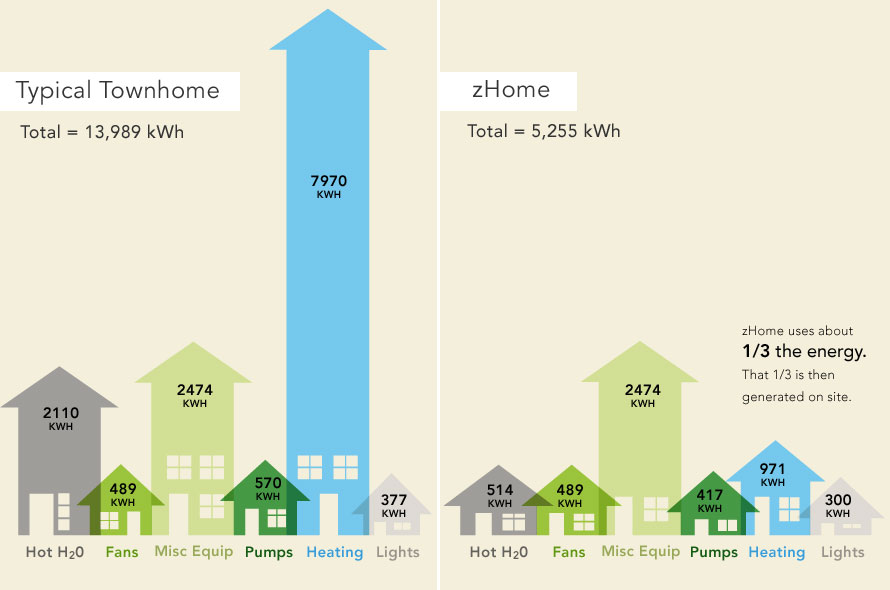
This graphic demonstrates where the zHome is reducing 2/3 of the energy usage of a typical townhome built to code.
Through the above measures, the zHome uses about 1/3 of the energy that a typical townhome of the same size and design would use. The remaining 1/3 of energy is then supplied by the rooftop solar panels.
The wild card in getting to Zero Energy is the residents. Studies show that energy use in the same home with different families can vary dramatically. However, the units all have an instant energy feedback monitor, showing how much energy is being used at the moment and over the course of the year. This allows the residents to continually track their energy use and make lifestyle changes to reduce that use.
The zHome received the Energy Petal Certification from the Living Building Challenge in 2013. Read more about the zHome approach at their website.
R-951 Residence
Brooklyn, New York
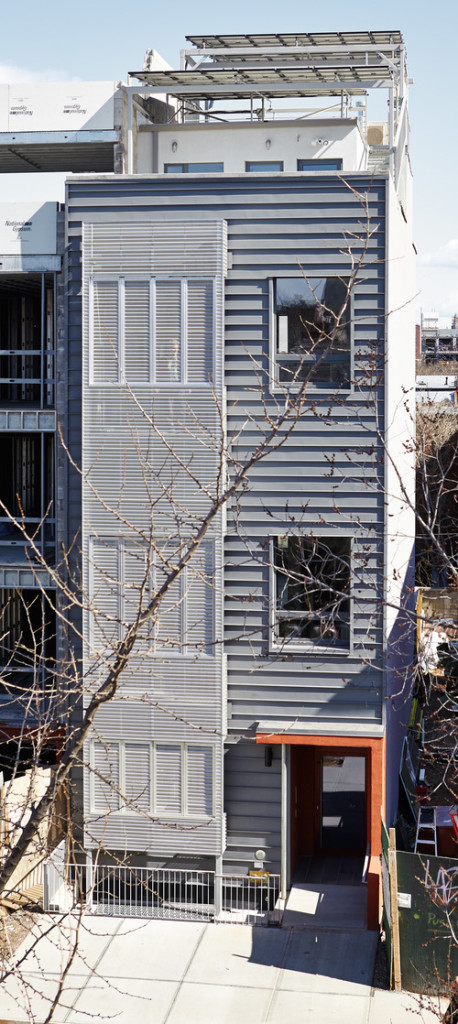 The R-951 Residence is a 5,600 square foot, four story row house in Prospect Heights, Brooklyn and is a unique project demonstrating that Zero Energy is attainable in dense urban environments. The building, designed by Paul A. Castrucci, Architect, has three 1,500 square foot apartments, each with its own solar panels and electric systems.
The R-951 Residence is a 5,600 square foot, four story row house in Prospect Heights, Brooklyn and is a unique project demonstrating that Zero Energy is attainable in dense urban environments. The building, designed by Paul A. Castrucci, Architect, has three 1,500 square foot apartments, each with its own solar panels and electric systems.
The apartment building uses Passive House design and building principles to reduce the energy usage by 75% for heating, cooling and lighting, then uses the 12.5 kW solar panel system to offset the remaining energy used. The building envelope is virtually air tight with triple paned windows, high R-Value insulation, and a combination of high solar heat gain and efficient heat pumps for heating.
In April 2015, the New York State Energy Research and Development Authority rated the building as Net Zero Capable, meaning that each apartment has the ability to generate enough renewable energy to meet or exceed its annual energy demand. In July 2015, R-951 received Passive House certification from the Passive House Institute.
This multifamily residence demonstrates that Net Zero capable buildings can be constructed cost-effectively in urban environments. The proportion of the building’s available square footage to the size of the solar PV system demonstrates that many sites in New York City have the potential to achieve Net Zero in accordance with the current zoning regulations. It’s also important to point out that R-951 was also constructed with only a 4.7% increase in development cost, compared to a similar code-built structure, to achieve its zero energy goal.
Read more about the R-951 Residence here.
Perrin’s Row
Wheat Ridge, Colorado
New Town Builders’ Perrin’s Row town homes are built to the rigorous energy efficiency requirements of the U.S. Department of Energy’s Zero Energy Ready Home program. Located in Wheat Ridge, Colorado, the 26-unit project is shining example of a certified Zero Energy Ready Home in a cold climate.
The project, to be completed December 2015, is projected to save each home owner nearly $700 in energy bills per year. To get certified as a Zero Energy Ready Home, this project focused first on a high-performance building envelope and then on highly efficient lighting, HVAC and appliances. Specifics include:
- Advanced 2×6”, 24” on center, framed walls with insulated headers, blown in fiberglass insulated (rated at R-23), and asphalt spray-on weather resistant barrier and seam sealer.
- Vented attic with 14” raised heel trusses and blown-in fiberglass insulation rated at R-50.
- A roof system with 3 foot ice and water shield, waterproof underlayment, 30-year shingles and metal drip edge.
- Rigid foam under slab foundation for R-10 insulation value.
- Double pane, argon-filled, vinyl framed, low-e windows with U value of .30.
- Sealed building envelope at 2.48 ACH 50.
- Exhaust fan ventilation.
- Efficient HVAC system with a 92 AFUE furnace and 13 SEER AC.
- 95% efficient tankless hot water heaters.
- 100% CFL lighting.
- ENERGY STAR-rated refrigerators and dishwashers.
- 3.0 kWh solar panels to be included on each town home to help offset the electrical use. The units are leased through a solar leasing program with a national company.
- Energy management system that tracks each unit’s solar system production and overall electricity consumption.
In addition to high energy performance, the units all include water conservation measures such as EPA WaterSense-rated fixtures, smart controls, drip irrigation and drought tolerant plants as well as low-VOC finishes throughout the buildings. New Town Builders estimates that all of these energy improvements that greatly improve the building performance only added $6 per square foot to the construction budget.
Perrin’s Row town homes recently received a Grand Winner Award for the DOE’s Housing Innovation Awards in 2015.
Resources for Zero Energy Multifamily Buildings
The U.S. Department of Energy’s Zero Energy Ready Home program provides resources for successfully building and selling zero energy ready single family and multi-family homes.
The DOE Better Buildings Challenge supports commercial and industrial building owners by providing technical assistance and proven solutions to energy efficiency.
The American Council for an Energy-Efficient Economy (ACEEE), with the support of the John D. and Catherine T. MacArthur Foundation, is engaged in a multi-year project to improve and expand utility energy efficiency programs that target multifamily housing.
Are you involved in a multi-family project that is working towards Zero Energy? We’d love to hear from you and share the story! Please feel free to leave a comment below or send us a direct email with your thoughts or project information.
